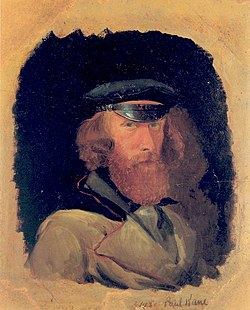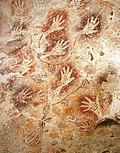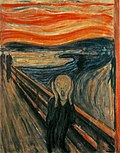Portal:Visual arts
Introduction

The visual arts are art forms such as painting, drawing, printmaking, sculpture, ceramics, photography, video, image, filmmaking, design, crafts, and architecture. Many artistic disciplines such as performing arts, conceptual art, and textile arts, also involve aspects of the visual arts, as well as arts of other types. Within the visual arts, the applied arts, such as industrial design, graphic design, fashion design, interior design, and decorative art are also included.
Current usage of the term "visual arts" includes fine art as well as applied or decorative arts and crafts, but this was not always the case. Before the Arts and Crafts Movement in Britain and elsewhere at the turn of the 20th century, the term 'artist' had for some centuries often been restricted to a person working in the fine arts (such as painting, sculpture, or printmaking) and not the decorative arts, crafts, or applied visual arts media. The distinction was emphasized by artists of the Arts and Crafts Movement, who valued vernacular art forms as much as high forms. Art schools made a distinction between the fine arts and the crafts, maintaining that a craftsperson could not be considered a practitioner of the arts.
The increasing tendency to privilege painting, and to a lesser degree sculpture, above other arts has been a feature of Western art as well as East Asian art. In both regions, painting has been seen as relying to the highest degree on the imagination of the artist and being the furthest removed from manual labour – in Chinese painting, the most highly valued styles were those of "scholar-painting", at least in theory practiced by gentleman amateurs. The Western hierarchy of genres reflected similar attitudes. (Full article...)
Selected article

Léal Souvenir (also known as Timotheus or Portrait of a Man) is a small oil-on-oak panel portrait by the Early Netherlandish painter Jan van Eyck, dated 1432. The sitter has not been identified, but his distinctive features suggest a historical person rather than the hypothetical ideal usual at the time in northern Renaissance portraiture; his slight and unassuming torso is contrasted with a sophisticated facial expression. His features have been described as "plain and rustic", yet thoughtful and inward-looking. The sitter was apparently significant enough a member of the Burgundian duke Philip the Good's circle that his court painter portrayed him.
The man sits before an imitation parapet with three sets of painted inscriptions, each rendered to look as if chiselled or scratched into stone. Van Eyck did not have full command of either classical Greek or Latin and made errors, so readings by modern scholars vary. The first inscription is in Greek and seems to spell "TYΜ.ωΘΕΟϹ", which has not been satisfactorily interpreted but has led some to title the work Timotheus. The middle reads in French "Leal Souvenir" ("Loyal Memory") and indicates that the portrait is a posthumous commemoration. The third records van Eyck's signature and the date of execution. The 19th-century art historian Hippolyte Fierens-Gevaert identified the lettering "TYΜ.ωΘΕΟC" with the Greek musician Timotheus of Miletus. Panofsky drew the same conclusion, eliminating other Greeks bearing the name Timothy; they were of religious or military background, professions that do not match the civilian dress of the sitter. Panofsky believed the man was probably a highly placed musician in Philip's court, possibly Gilles Binchois. (Full article...)
Selected picture
Selected quote
Related portals
Selected biography
Paul Kane (September 3, 1810 – February 20, 1871) was an Irish-born Canadian painter whose paintings and especially field sketches were known as one of the first visual documents of Western indigenous life.
A largely self-educated artist, Paul Kane grew up in York, Upper Canada (now Toronto) and trained himself by copying European masters on a "Grand Tour" study trip through Europe. He undertook two voyages through the Canadian northwest in 1845 and from 1846 to 1848. The first trip took him from Toronto to Sault Ste. Marie and back. Having secured the support of the Hudson's Bay Company, he set out on a second, much longer voyage from Toronto across the Rocky Mountains to Fort Vancouver (present-day Vancouver, Washington) and Fort Victoria (present day Victoria, British Columbia). (Full article...)
Did you know (auto generated) -

- ... that Mayu Sakai found drawing Peter Pan Syndrome difficult because of its fantasy elements?
- ... that Nickelodeon storyboard artists created a book with hundreds of pornographic drawings of SpongeBob SquarePants characters?
- ... that in May 1983 British public health physician Spence Galbraith suggested withdrawing blood products made from blood donated in the U.S. after 1978?
- ... that The Wiccan Web recommends drawing pentagrams on your computer screen with tinctures?
- ... that Sarah Pickstone based her John Moores Prize–winning painting on an illustration that accompanied the poem "Not Waving but Drowning"?
- ... that the art of Irma Blank, of "drawing languages without words" and including sounds, was recognised in the 1970s but fell into obscurity until a rediscovery in the 2010s?
- ... that the filmmakers of Cyborgs wrote dialogue in both Russian and Ukrainian to show the diversity of the eponymous soldiers who defended Donetsk Airport in late 2014?
- ... that Mexican filmmaker David Zonana wrote his first feature film after producing for two other directors?
General images
Major topics
- Types of visual art – Architecture • Art intervention • Ceramic art • Computer art • Drawing • Fashion • Film • Installation art • Land art • Mixed media • Painting • Performance art • Photography • Printmaking • Sculpture • Stained glass; • Artists' Books
- Art history – Pre-historic art • Ancient art • Art of Ancient Egypt • Art in Ancient Greece • Minoan pottery • Scythian art • Roman art • Women artists
- Western art periods and movements – Medieval art • Gothic art • Renaissance • Mannerism • Baroque • Rococo • Neoclassicism • Romanticism • Realism • Modern Art • Impressionism • Symbolism • Fauvism • Proto-Cubism • Cubism • Futurism • Dada • Art Deco • Surrealism • Abstract Expressionism • Lyrical abstraction • Conceptual Art • Contemporary Art • Postmodern art visual arts.
- Eastern and Middle Eastern art – Buddhist art • Chinese art • Islamic art • Japanese art • Laotian art • Thai art • Tibetan art
- Lists – Architects • Art movements • Art periods • Painters • Printmakers • Sculptors • Statues
- Lists of basic topics – Visual arts • Architecture • Film • Painting • Photography • Sculpture
Subcategories

Architecture | Ceramic art | Comics | Crafts | Design | Drawing | Illustration | Film | Glass | Graphic design | Industrial design | Landscape architecture | Multimedia | Painting | Photography | Pottery | Printmaking | Public art | Sculpture | Typography | Mosaic
Artists | Visual arts awards | Artist collectives | Art collectors | Art critics | Art curators | Visual arts exhibitions | Art forgery | Art history | Visual arts materials | Art schools | Artistic techniques |
WikiProjects
Things you can do
Associated Wikimedia
The following Wikimedia Foundation sister projects provide more on this subject:
-
Commons
Free media repository -
Wikibooks
Free textbooks and manuals -
Wikidata
Free knowledge base -
Wikinews
Free-content news -
Wikiquote
Collection of quotations -
Wikisource
Free-content library -
Wikiversity
Free learning tools -
Wiktionary
Dictionary and thesaurus







































































